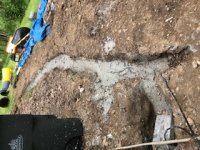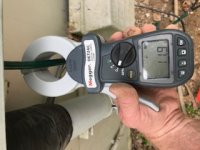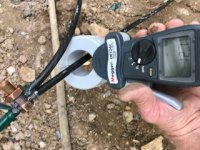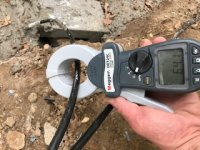So, I've made progress on grounding.
After drilling and sawing away footer concrete to reach rebar, and then filing away at the rebar, the results, as measured by the Megger DET 24C Ohm meter, were not great: 135 ohms which is higher than my old ground at 85 ohms.
So, I disconnected the ground wire from the rebar and connected to stainless steel rods. They are laid horizontal in a 30 foot trench about 30" deep, with a Bentonite slurry in the trench.
The meter now measures 18 ohms, so a big improvement! I'll continue to add another 100 lbs of powdered Bentonite to be power-mixed with water to fill the rest of the trench. Bentonite absorbs water x 60 so that will be another 6000 lbs of slurry into the trench which should continue to increase the conductivity-- I hope.
I also may run another wire from the rebar to the rod and cover the drilled out footer area with a concrete/bentonite mix. I'll see if that increases conductivity further.
Finally, the Ohm meter has been essential for someone like me to have an idea of what's working and what's not. These meters sell for $1700, but I found a place in Texas that rents the for $10/day: Protec Equipment Resources.
After drilling and sawing away footer concrete to reach rebar, and then filing away at the rebar, the results, as measured by the Megger DET 24C Ohm meter, were not great: 135 ohms which is higher than my old ground at 85 ohms.
So, I disconnected the ground wire from the rebar and connected to stainless steel rods. They are laid horizontal in a 30 foot trench about 30" deep, with a Bentonite slurry in the trench.
The meter now measures 18 ohms, so a big improvement! I'll continue to add another 100 lbs of powdered Bentonite to be power-mixed with water to fill the rest of the trench. Bentonite absorbs water x 60 so that will be another 6000 lbs of slurry into the trench which should continue to increase the conductivity-- I hope.
I also may run another wire from the rebar to the rod and cover the drilled out footer area with a concrete/bentonite mix. I'll see if that increases conductivity further.
Finally, the Ohm meter has been essential for someone like me to have an idea of what's working and what's not. These meters sell for $1700, but I found a place in Texas that rents the for $10/day: Protec Equipment Resources.




